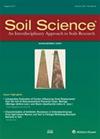Wetting and drying cycles, organic amendments, and gypsum play a key role in structure formation and stability of sodic Vertisols
4区 农林科学
Q2 Agricultural and Biological Sciences
引用次数: 1
Abstract
Abstract. In the natural environment, soils undergo wetting and drying (WD) cycles due to precipitation and evapotranspiration. The WD cycles have a profound impact on soil physical, chemical, and biological properties and drive the development of structure in soils. Degraded soils are often lacking structure, and the effect of organic amendments and WD cycles on structure formation of these soils is poorly understood. The aim of this study was to evaluate the role of biotic and abiotic factors on aggregate formation and stabilization of sodic soils after the addition of gypsum and organic amendments (feedlot manure, chicken manure, lucerne pallets, and anionic poly acrylamide). Amended soils were incubated at 25 ∘C over four WD cycles, with assessment of soil microbial respiration, electrical conductivity, pH, sodium adsorption ratio (SAR), aggregate stability in water (ASWAT), aggregate size distribution, and mean weight diameter. Our results demonstrate that WD cycles can improve aggregate stability after the addition of amendments in sodic Vertisols, but this process depends on the type of organic amendment. Lucerne pellets resulted in highest soil microbial respiration, proportions of large macroaggregates (>2000 µm), and mean weight diameter. In contrast, dispersion was significantly reduced when soils were treated with chicken manure, whilst anionic polyacrylamide only had a transient effect on aggregate stability. When these organic amendments were applied together with gypsum, the stability of aggregates was further enhanced, and dispersion became negligible after the second WD cycle. The formation and stability of small macroaggregates (2000–250 µm) was less dependent on the type of organic amendments and more dependent on WD cycles as the proportion of small macroaggregates also increased in control soils after four WD cycles, highlighting the role of WD cycles as one of the key factors that improves aggregation and stability of sodic Vertisols.干湿循环、有机改进剂和石膏对钠基垂直溶胶的结构形成和稳定性起着关键作用
摘要在自然环境中,由于降水和蒸散作用,土壤经历了干湿循环。WD循环对土壤的物理、化学和生物特性有着深远的影响,并驱动着土壤结构的发展。退化土壤通常缺乏结构,有机改良剂和WD循环对这些土壤结构形成的影响尚不清楚。本研究的目的是评价添加石膏和有机改进剂(饲养场粪肥、鸡粪、苜蓿草和阴离子聚丙烯酰胺)后,生物和非生物因素对碱土团聚体形成和稳定性的作用。将改良过的土壤在25°C下培养4个周期,评估土壤微生物呼吸、电导率、pH、钠吸附比(SAR)、水中团聚体稳定性(ASWAT)、团聚体粒径分布和平均重量直径。我们的研究结果表明,WD循环可以提高在添加了有机改性剂后的聚类稳定性,但这一过程取决于有机改性剂的类型。Lucerne颗粒导致最高的土壤微生物呼吸,大团聚体比例(>2000µm)和平均重量直径。相比之下,鸡粪处理显著降低了土壤的分散性,而阴离子聚丙烯酰胺对团聚体稳定性只有短暂的影响。当这些有机改进剂与石膏一起使用时,集料的稳定性进一步提高,并且在第二次WD循环后分散性变得可以忽略不计。小团聚体(2000-250µm)的形成和稳定性对有机修正类型的依赖程度较低,而对WD循环的依赖程度较高,在4个WD循环后,对照土壤中小团聚体的比例也有所增加,这表明WD循环是改善土壤聚类和稳定性的关键因素之一。
本文章由计算机程序翻译,如有差异,请以英文原文为准。
求助全文
约1分钟内获得全文
求助全文
来源期刊

Soil Science
农林科学-土壤科学
CiteScore
2.70
自引率
0.00%
发文量
0
审稿时长
4.4 months
期刊介绍:
Cessation.Soil Science satisfies the professional needs of all scientists and laboratory personnel involved in soil and plant research by publishing primary research reports and critical reviews of basic and applied soil science, especially as it relates to soil and plant studies and general environmental soil science.
Each month, Soil Science presents authoritative research articles from an impressive array of discipline: soil chemistry and biochemistry, physics, fertility and nutrition, soil genesis and morphology, soil microbiology and mineralogy. Of immediate relevance to soil scientists-both industrial and academic-this unique publication also has long-range value for agronomists and environmental scientists.
 求助内容:
求助内容: 应助结果提醒方式:
应助结果提醒方式:


